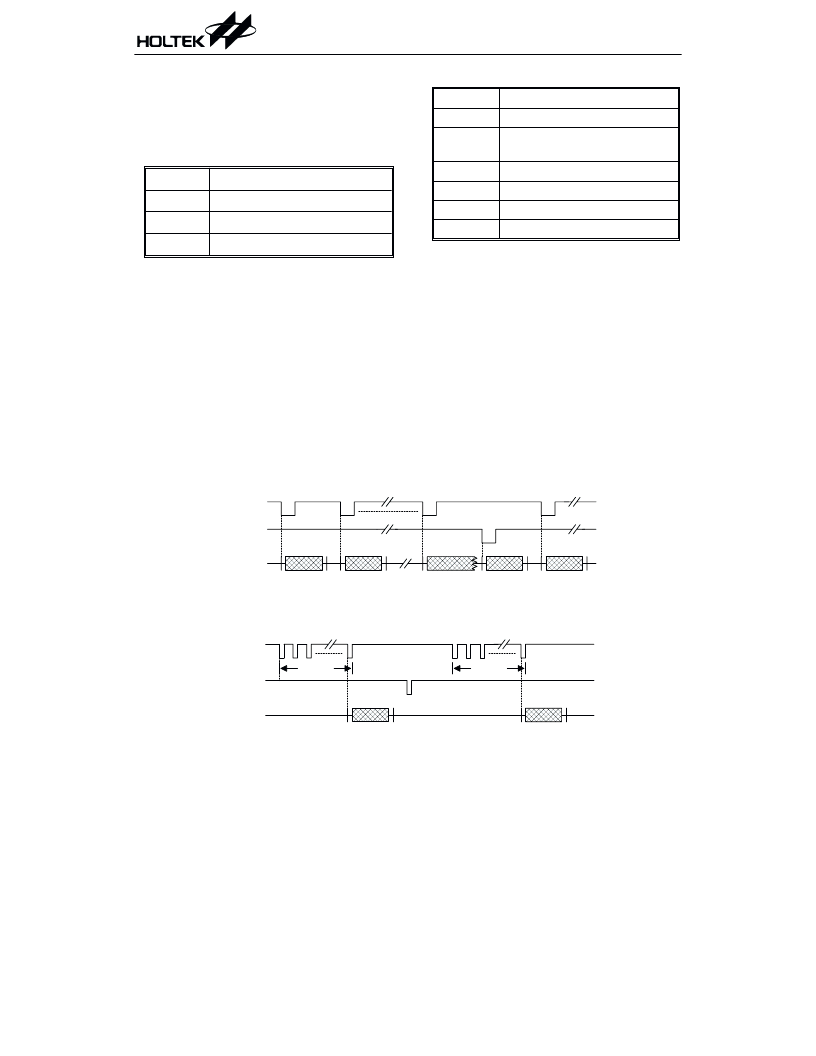- 您現(xiàn)在的位置:買賣IC網(wǎng) > PDF目錄370715 > HT817D0(24DIP) Speech Synthesizer PDF資料下載
參數(shù)資料
| 型號: | HT817D0(24DIP) |
| 英文描述: | Speech Synthesizer |
| 中文描述: | 語音合成器 |
| 文件頁數(shù): | 7/15頁 |
| 文件大?。?/td> | 207K |
| 代理商: | HT817D0(24DIP) |

HT817D0
7
March 15, 2000
KEY1 as a direct key
Each key is mapped to a group in the
function table. If a key is not used, the group
mapped to that key is a piece of silence.
Thefollowingisanexampleofthefunctionta-
ble:
Group 1
sec.1 + sec.2 + sec.3 + sec.5
Group 2
sec.3
Group 3
sec.2 + sec.2 + sec.3 + sec.4
Group 4
sec.5 + sec.3
Asillustratedintheabovetable,voiceROMis
composed of 5 sections and the function table
of 11 sections. If KEY1 is momentarily trig-
gered, section 1, section 2, section 3 and sec-
tion 5 are played in sequence and then
stopped. Triggering KEY2 plays section 3,
and so forth.
KEY1 as a sequential or random key
WhenKEY1isoptionedasasequentialorran-
dom key, it can include multiple groups
(sub-groups) in the function table. However,
the remaining 11 keys (KEY2~KEY12) are used
as direct keys exclusively and comprise only
one group in the function table.
An example is shown below:
Group 1-1 sec.4 + sec.2
Group 1-2 sec.1 + sec.3
:
:
:
:
Group1-N sec.2 + sec.3
Group 2
sec.2 + sec.3
Group 3
sec.3 + sec.5
Group 4
sec.1 + sec.5 + sec.2
As indicated in the above table, KEY1 can be
made up of sub-groups. Each time KEY1 is
triggered, the corresponding sub-groups are
played in sequence.
The playing sequence of sequential KEY1 is:
Group 1-1
Group 1-2
Group 1-N (the last group)
The playing sequence of random KEY1 is:
Group 1-3
Group 1-5
Group 1-3
Group 1-5 .....
That KEY1 functions as a random key is a
special case of sequential key, which com-
bines a particular arrangement of sub-group
playing sequence.
Group 1-3 .....
Group 1-1 .....
Group 1-N
/ & "
/ & "
/ & "
/ & 1 < 3
/ & "
<
Figure1 Reset of KEY1 playing sequence
/ & "
& / ) #
/ & " -
- & / ) #
<
1)3
Figure 2 KEY1 sub-group selection
Powered by ICminer.com Electronic-Library Service CopyRight 2003
相關(guān)PDF資料 |
PDF描述 |
|---|---|
| HT817D0(24SOP) | Speech Synthesizer |
| HT817D0 | 16.8-Second LOG-PCM Speech |
| HT818D0(20DIP) | Speech Synthesizer |
| HT818D0(20SOP) | Speech Synthesizer |
| HT818D0(24DIP) | Speech Synthesizer |
相關(guān)代理商/技術(shù)參數(shù) |
參數(shù)描述 |
|---|---|
| HT818D0 | 制造商:HOLTEK 制造商全稱:Holtek Semiconductor Inc 功能描述:22.4-Second LOG-PCM Speech |
| HT818D0(20DIP) | 制造商:未知廠家 制造商全稱:未知廠家 功能描述:Speech Synthesizer |
| HT818D0(20SOP) | 制造商:未知廠家 制造商全稱:未知廠家 功能描述:Speech Synthesizer |
| HT818D0(24DIP) | 制造商:未知廠家 制造商全稱:未知廠家 功能描述:Speech Synthesizer |
| HT818D0(24SOP) | 制造商:未知廠家 制造商全稱:未知廠家 功能描述:Speech Synthesizer |
發(fā)布緊急采購,3分鐘左右您將得到回復(fù)。